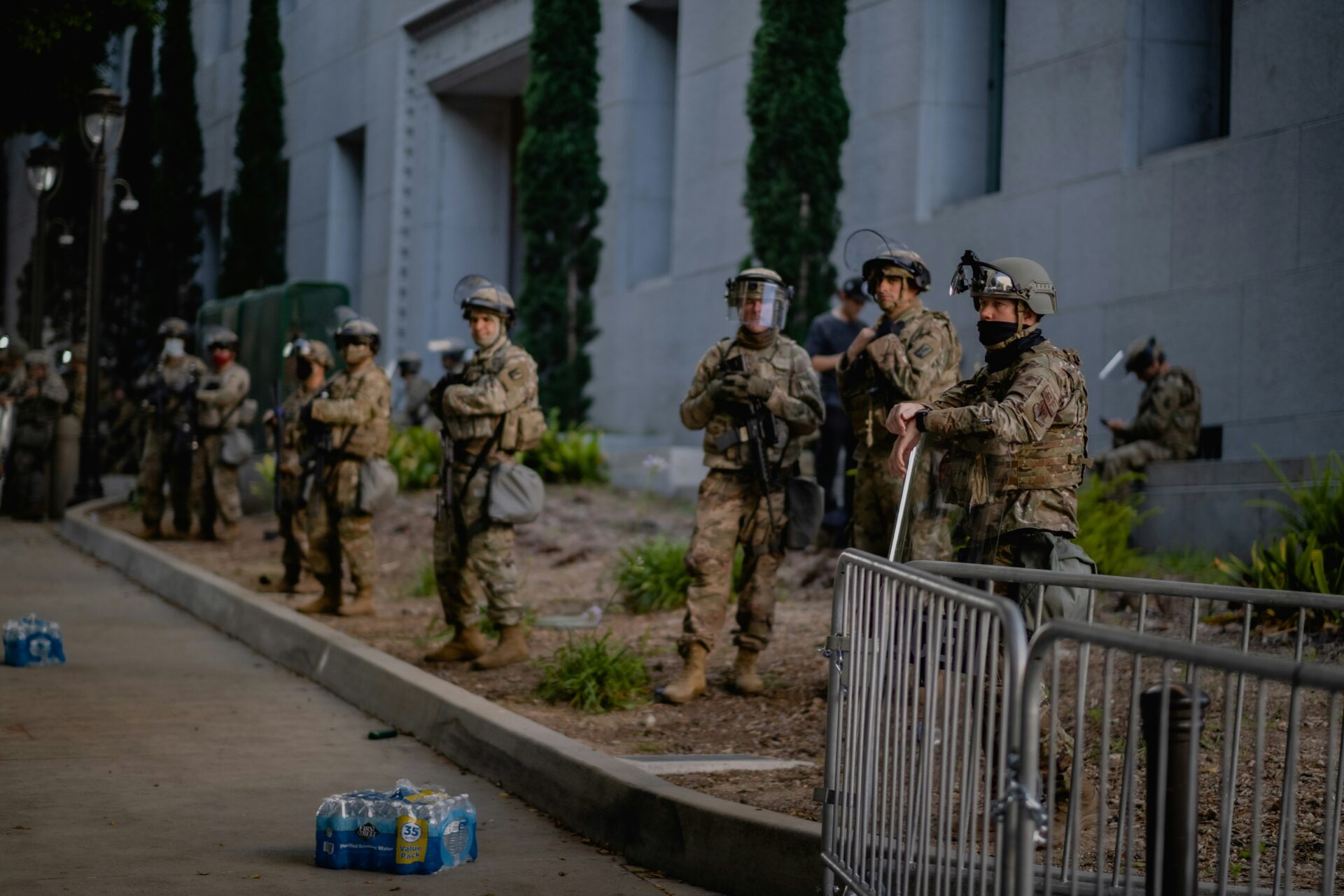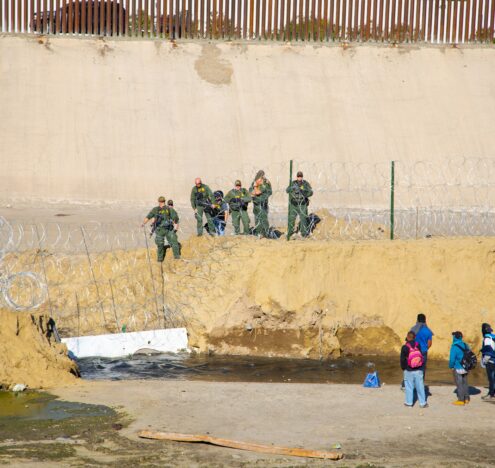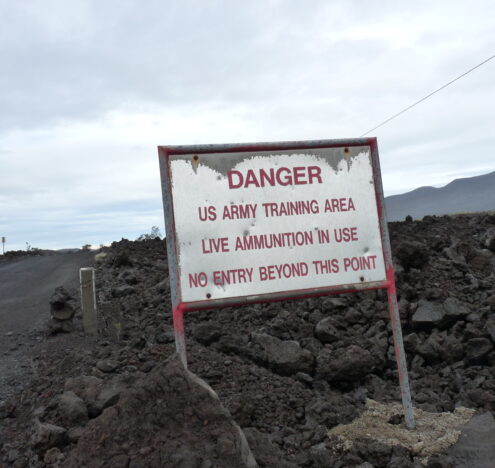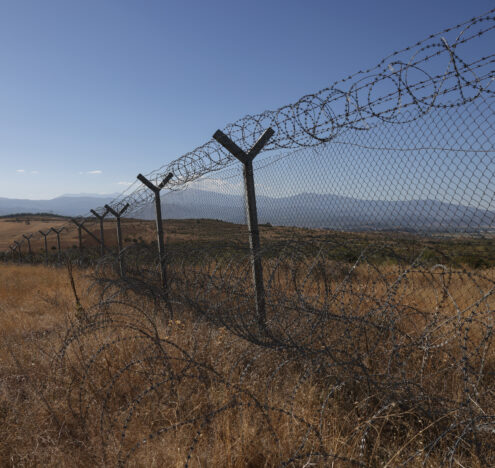Earlier this summer, the same week the Trump administration sent the National Guard to Los Angeles, a California-based military officer called Michael* was in a meeting with fellow personnel. The conversation turned to what was happening in LA, and one guy spoke up, saying he’d like to volunteer to go. After all, they’d heard LA was so dangerous that no one could walk the streets unafraid anymore. “Another guy chimes in,” Michael recalls, “and he’s like, ‘Yeah, let’s go bash some skulls.’”
To avoid potential retribution, Michael doesn’t want to use his real name or share what branch of service he’s in. But he’s found creative ways to share his perspectives. For a little over a year, he’s been making anonymous TikTok videos that give people a window into a military culture he describes as racist. He says there’s also frequent discussion of violence towards civilians either at home or abroad, and after the murder of right-wing activist Charlie Kirk, Michael worries the recent militarization of American cities will only get worse.
“The American right conceptualizes their political enemies and the Democratic Party as a powerful hostile foreign insurgency,” he says. “Now with the clear path to escalation they have already been on, I definitely see a reaction where they take this National Guard and ICE energy and pivot it towards people of left-leaning ideals.”
Experts, advocates, and attorneys say an increased military and law enforcement presence will impact marginalized communities the most. Even though many of the people recently arrested during the National Guard’s occupation of DC have seen their charges dismissed, the chaos caused by their presence — coupled with an uptick in ICE raids — poses grave threats to communities in the administration’s crosshairs.
“We’ve had a lot of primary breadwinners ripped from their homes, and I think that should scare more people,” says Amy Fisher, an organizer at the DC-based Migrant Solidarity Mutual Aid Network. “When people are able to be snatched off our street with no probable cause, then thrown into a detention center with no due process and no timetable for release, that’s a threat to all of us.”
Charles Henderson, a military veteran and veterans advocate from Chicago, estimates that the majority of both veterans and active-duty military personnel lean conservative. Multiple studies back this up. There’s also evidence that this political divide is being deepened by those in charge.
For instance, Amy Cooter, a director at the Middlebury Institute’s Center on Terrorism, Extremism, and Counterterrorism, has researched how “Fox News is treated as though it is official military news on many bases, contributing to a hostile environment, an echo chamber, and a suppression of contradictory political views.”
Cooter previously told Inkstick that Secretary of Defense and former Fox News personality Pete Hegseth’s recent actions, including advocating for the pardoning of war criminals and disbanding studies on extremism, could have a trickle-down effect on the military, fostering institutionalized acceptance of extreme ideas and discouraging people from enlisting. Research studies back up Cooter and indicate that, even if large-scale extremist acts don’t originate from within the military, the flourishing of racist or extremist thinking can disrupt a unit’s effectiveness and the military’s ability to work with allies around the world.
Kris Goldsmith, an Iraq War veteran who founded Task Force Butler to investigate and counteract extremist groups, says the “MAGA-fication” of the military has been an overlooked trend. When the National Guard deploys to US cities, “generals aren’t fucking on the line holding a shield or baton,” Goldsmith says. “The young people who would be in those positions grew up in the era of Trump, many enlisted while Trump was president, and all of them enlisted in the last 10 years knowing that Trumpism exists and that it’s a political force.”
Michael, the military officer based in California, has seen that “MAGA-fication” up close and personal. He worries sending the National Guard to more cities poses serious risks, especially since, in his experience, military personnel are “softened at the idea of abusing their fellow people.”
But the politicization of other government branches, especially the Department of Homeland Security, worries him even more.
He points out that ICE has reduced age requirements and largely inflated hiring bonuses while framing their mission as a patriotic endeavor akin to military service. In a recent interview with Politico, ICE Deputy Director Madison Sheahan said 30% of the agency’s 110,000 new applicants are military veterans.
Henderson, the veteran from Chicago, is a Black man with Mexican heritage. He spends a lot of his time helping veterans in the city’s South Side access their health benefits, including many people of color who didn’t fully benefit from the original GI bill because of housing, education and employment discrimination.
He talked with Inkstick while the Trump administration was still considering sending the National Guard to Chicago — a move he considers a slap in the face.
“It’s not their mission, and we’ve seen what happened in DC,” Henderson says. “A lot of those guys ended up picking up trash and clearing homeless encampments, so it seemed to be more about a show of force than anything.”
Plus, he adds, “I don’t want anyone to get hurt, here in Chicago or in the National Guard.”
Trump ultimately pivoted his focus from Chicago to Memphis, where he plans to deploy federal troops despite a 25-year low in crime. But around the same time he made that decision, a 38-year-old father named Silverio Villegas-Gonzalez was shot and killed by ICE agents in the Chicago suburb of Franklin Park.
ICE later said Villegas-Gonzales was resisting arrest, and an agent was dragged by a vehicle during the incident. According to friends and colleagues, the father of two was scared by the recent ICE activity in his area — activity the Trump administration dubbed “Operation Midway Blitz.”
The operation was ostensibly designed to target undocumented immigrants with criminal records, though the only violations on Villegas-Gonzales’s record were traffic-related. And recently, local activists have called into question why he was shot dead when he was unarmed.
Congressman Brad Schneider, a Democrat who represents Franklin Park, released a statement after the shooting that read, in part, “President Trump’s strategy to use intimidation and chaos in his ‘Operation Midway Blitz’ is creating a climate of anxiety and fear, something that is bad for everyone. This climate of fear increases the likelihood of circumstances that threaten our community’s safety and the safety of our public safety officials, too.”
A few days after Villegas-Gonzales was killed, Eréndira Rendon, vice president of Immigrant Justice at the Chicago-based Resurrection Project, told Inkstick that ICE arrests in the Chicago area had dramatically increased. During the weekend of September 12, her organization received four times as many requests for attorneys as they did the previous weekend. (At the time of publication, the Department of Homeland Security claims Operation Midway Blitz has led to more than 500 arrests.)
What most worries Rendon is the speed with which these arrestees — and others in the future — could be moved out of Chicago. The Trump administration is arguing that anyone who entered the country without legal documentation is “forever eligible for expedited removal,” regardless of how long they have lived in the US. In some cases, this means people are being deported within 48 hours of their arrest — often before their legal counsel can arrive. “Basically every kind of due process protection is dead,” Rendon says.
The longtime immigrants’ rights advocate worries about what these deportations will do to her city. “Part of what makes Chicago really beautiful is immigrant neighborhoods,” she says. “You can go from feeling like you’re in Mexico to feeling like you’re in China, to feeling like you’re in India, and that’s important to the cultural vibrancy of Chicago.”
Amanda Garcia thinks this vibrancy is part of the reason Chicago was targeted by the Trump administration. Garcia, who now works for the Acacia Center for Justice in Illinois, was an immigration attorney during the first Trump administration, a time that she says was marked by a lot of “rule-bending.” Now, the rules are being broken.
In addition to the rampant due process violations also highlighted by Rendon, Garcia cites the recent case where the Trump administration tried to deport children to Guatemala under the false pretense that the children’s parents wanted them deported. That effort was blocked by a Trump-appointed judge, and both Garcia and Rendon hope more courts will stand up for the law — especially now that the Supreme Court has, as some advocates put it, “effectively legalized racial profiling.”
In a move that mirrors the administration’s efforts to shape the military and immigration forces, Rendon points out, “That’s why you’ve seen so many firings of judges — because they’re just trying to put in folks that are just going to do what they’re told, versus actually follow the law.”
Garcia was blunt about what this means for people and their communities. “Too often, the system is working against the people,” she says. “And when the system works against people, it’s those who are already most vulnerable who hurt the most.”




















